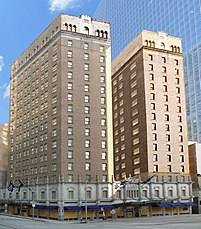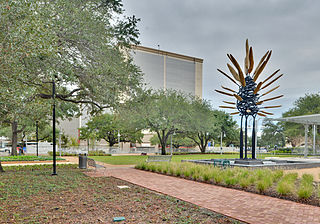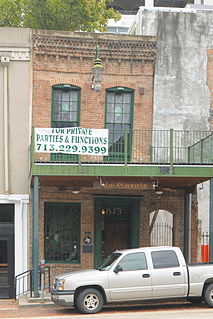
Elgin is a city in Bastrop and Travis Counties in the U.S. state of Texas. The population was 8,135 at the 2010 census. The city is a suburb of Austin, and is part of the Greater Austin metropolitan area. Elgin is also known as the Sausage Capital of Texas and the Brick Capital of the Southwest, due to the presence of three operating brickyards in the mid-20th century.

The Financial District of Lower Manhattan, also known as FiDi, is a neighborhood located on the southern tip of Manhattan island in New York City. It is bounded by the West Side Highway on the west, Chambers Street and City Hall Park on the north, Brooklyn Bridge on the northeast, the East River to the southeast, and South Ferry and the Battery on the south.

The Texas State Capitol is the capitol building and seat of government of the American state of Texas. Located in downtown Austin, Texas, the structure houses the offices and chambers of the Texas Legislature and of the Governor of Texas. Designed in 1881 by architect Elijah E. Myers, it was constructed from 1882 to 1888 under the direction of civil engineer Reuben Lindsay Walker. A $75 million underground extension was completed in 1993. The building was added to the National Register of Historic Places in 1970 and recognized as a National Historic Landmark in 1986.

The Galveston Seawall is a seawall in Galveston, Texas, that was built after the Galveston Hurricane of 1900 for protection from future hurricanes. Construction began in September 1902, and the initial segment was completed on July 29, 1904. From 1904 to 1963, the seawall was extended from 3.3 miles (5.3 km) to over 10 miles (16 km).

The Driskill, a Romanesque-style building completed in 1886, is the oldest operating hotel in Austin, Texas, United States, and one of the best-known hotels in Texas generally. The Driskill was conceived and built by Col. Jesse Driskill, a cattleman who spent his fortune constructing "the finest hotel south of St. Louis".

The Club Quarters Hotel is a 16-story, 61.6 m (202 ft) Beaux-Arts high-rise at 710 Fannin Street in downtown Houston, Texas, USA. The building is listed on the National Register of Historic Places as the Texas State Hotel.

The Dallas County Courthouse, built in 1892 of red sandstone with rusticated marble accents, is a historic governmental building located at 100 South Houston Street in Dallas, Texas. Also known as the Old Red Courthouse, it became the Old Red Museum, a local history museum, in 2007. It was designed in the Richardsonian Romanesque style of architecture by architect Max A. Orlopp, Jr. of the Little Rock, Arkansas based firm Orlopp & Kusener. In 1966 it was replaced by a newer courthouse building nearby. On December 12, 1976, it was added to the National Register of Historic Places. In 2005–2007 the building was renovated.

Monroe Dunaway Anderson (1873–1939) was a banker and cotton trader from Jackson, Tennessee. With William L. Clayton, Anderson built Anderson, Clayton and Company into the world's biggest cotton company. In the event of one of their deaths, the partnership would lose a large amount of money to estate taxes and might be forced to dissolve. In order to avoid this, Anderson created the M.D. Anderson Foundation with an initial sum of $300,000. In 1939, after Anderson's death the foundation received an additional $19 million.

Franklin School is a historic school located at Schenectady in Schenectady County, New York. It was built in 1907 and is a two-story, red brick "H" shaped institutional building in the Georgian Revival style. It is trimmed with yellow brick and stone. There are massive yellow brick pilasters at the corner of the pavilions and recessed rectangular panels. It operated as a school by the Schenectady City School District until 1974.

Alfred Charles Finn was an American architect. He started in the profession with no formal training in 1904 as an apprentice for Sanguinet & Staats. He worked in their offices in Dallas, Fort Worth, and Houston. His credits during his tenure residential structures, but firm was a leader in steel-frame construction of skyscrapers.

Main Street Market Square Historic District is a historic district in Houston that includes the Market Square Park. It includes buildings nearby, as well as the square itself. It was listed on the National Register of Historic Places in 1983.

Gethsemane Lutheran Church is a historic Lutheran church in downtown Austin, Texas. Designated as a Recorded Texas Historic Landmark and listed on the National Register of Historic Places, the building currently holds offices of the Texas Historical Commission.

Malone Armory is a historic National Guard armory building located at Malone in Franklin County, New York. It is a brick and stone castle-like structure built in 1892, designed to be reminiscent of medieval military structures in Europe. It was designed by State Architect Isaac G. Perry. It consists of a 2-story, steeply pitched hipped roofed administration building with an attached 1 1⁄2-story, gable-roofed drill shed. The building is built of Potsdam sandstone and features a 3 1⁄2-story round tower on the administration building.

The Annunciation Church is a Catholic church located at the corner of Texas Avenue and Crawford Street in Downtown Houston, Texas.

The Borgstrom House is a historic house located at 1401 Cortland Street in Houston, Texas. It was listed on the National Register of Historic Places (NRHP) on 14 May 1984. It is within the boundaries of the Houston Heights MRA designated by the NRHP June 22, 1983.

The Burge House is a historic house located in Houston, Texas, United States. It was listed on the National Register of Historic Places on June 22, 1983. It is in the Houston Heights neighborhood, one of the first planned suburbs in Texas.

Eugene Thomas Heiner was an American architect who designed numerous courthouses, county jails, and other public buildings in Texas. He was born in New York City, apprenticed in Chicago, and studied further in Germany. His works includes buildings listed on the U.S. National Register of Historic Places.

Kennedy Bakery, located at 813 Congress Street in Houston, Texas, was listed on the National Register of Historic Places on July 27, 1979. The historic property in downtown Houston faces Market Square and lies within the Main Street Market Square Historic District. It is probably the "oldest Houston building existing on its original site."

Hannah Pickett Mill No. 1 was a historic textile mill complex located at Rockingham, Richmond County, North Carolina. The complex consisted of a large two story main building with Italianate style tower built between 1906 and 1908, and two large attached weave rooms, two adjacent cotton warehouses, and a small brick veneered office building dating from the early 1920s. The Hannah Pickett Mill administrative offices were housed in the Manufacturers Building. It has been demolished.

The Fayette County Courthouse Square Historic District in La Grange, Texas is a historic district roughly bounded by Main, Lafayette, Franklin, Colorado, Jefferson, Washington, and Crockett Streets. It was listed on the National Register of Historic Places on January 16, 2001. Two notable buildings in the district are the Fayette County Courthouse and Jail. Forty–seven buildings, three structures and four objects were identified as contributing to the historic nature of the district.






























